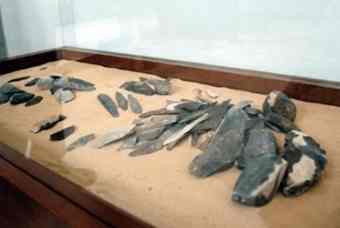An archaeological exhibition titled "Sawwan" (flint) showcasing stone artefacts found in Palmyra opened on Sunday at the National Museum in Damascus.
 The exhibition sheds light on finds from prehistoric times uncovered by the Syrian-French expedition working in the Om al-Tilal site near Palmyra. The artifacts on display consist of simple flint tools and household objects used by prehistoric humans in everyday life.
The exhibition sheds light on finds from prehistoric times uncovered by the Syrian-French expedition working in the Om al-Tilal site near Palmyra. The artifacts on display consist of simple flint tools and household objects used by prehistoric humans in everyday life.
In a statement to SANA, Minister of Culture Riad Naasan Agha said that new discoveries are made in Syria every day that underline Syria's cultural importance, adding that this exhibition is a cultural treasure that could very well be peerless in the world.
The Minister noted that Syrian-French cooperation in archeology dates back to 70 years ago, lauding the tireless work of Syrian and French expedition that led to uncovering many sites in Syria and stressing the need to continue cooperation in this field.
In a similar statement, French Ambassador in Damascus Eric Chevallier underlined the importance of this exhibition as it symbolizes cooperation between the Syrian and French governments, noting that the two countries cooperate in various cultural fields such as heritage, archeology and research.
For his part, Director General of Archeology and Museums Bassam Jamous said that the exhibition includes recent finds in the Palmyra desert area which was populated by Homo erectus around 1.3 million years ago.
He said that digs at various sites in the area uncovered flint axes and scraping tools, which helped provide new insight to researchers on the intellectual evolution of ancient humans who didn't just create tools for self-defense and hunting, but also gave them aesthetic qualities.
Jamous added that finds include a partial skull of a hominid that intrigued scientists, which calls for researching its civilization, evolution, behavior, qualities, language and relation to human evolution.
In turn, Director of the National Museum Hiba al-Sakhl, who also heads the Syrian side of the Syrian-French expedition working in Om al-Tilal site, said that archeological surveys and digs confirm that humans populated all areas of Syria continuously throughout history.
She noted that the exhibition is the first step in introducing the prehistoric civilization of Syria, and that other museums will hold similar exhibitions. She also stressed the importance of providing information about flint tools which are largely unknown in Syria, adding that the exhibition provides information about the development of flint usage in layman's terms for the general public.
For his part, head of the French side of the expedition Eric Boeda said that the exhibition reflects the 20-year-old cooperation between Syria and France at Om al-Tilal site, affirming that the finds are without match in the Middle East.
Author: H. Sabbagh | Source: Global Arab Network [September 06, 2010]